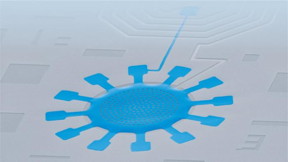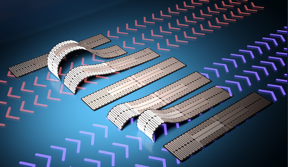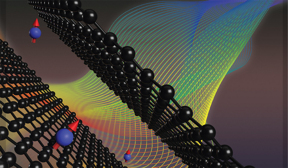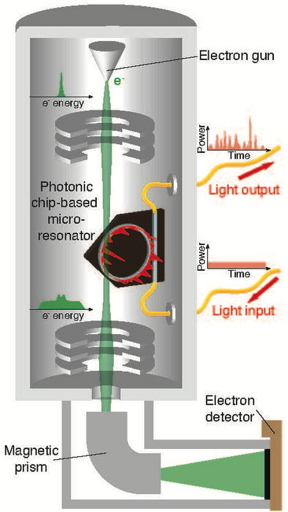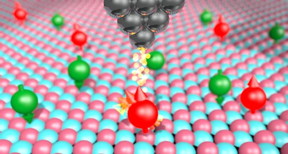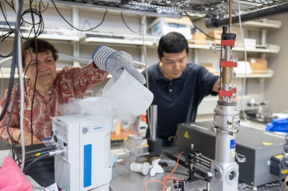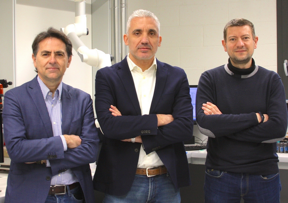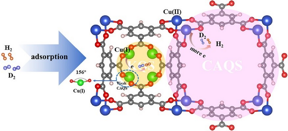Home > Press > First human trial shows ‘wonder’ material can be developed safely: A revolutionary nanomaterial with huge potential to tackle multiple global challenges could be developed further without acute risk to human health, research suggests
Abstract:
Carefully controlled inhalation of a specific type of graphene – the world’s thinnest, super strong and super flexible material – has no short-term adverse effects on lung or cardiovascular function, the study shows.
First human trial shows ‘wonder’ material can be developed safely: A revolutionary nanomaterial with huge potential to tackle multiple global challenges could be developed further without acute risk to human health, research suggests
Edinburgh, UK | Posted on February 16th, 2024
The first controlled exposure clinical trial in people was carried out using thin, ultra-pure graphene oxide – a water-compatible form of the material.
Researchers say further work is needed to find out whether higher doses of this graphene oxide material or other forms of graphene would have a different effect.
The team is also keen to establish whether longer exposure to the material, which is thousands of times thinner than a human hair, would carry additional health risks.
There has been a surge of interest in developing graphene – a material first isolated by scientists in 2004 and which has been hailed as a ‘wonder’ material. Possible applications include electronics, phone screens, clothing, paints and water purification.
Graphene is actively being explored around the world to assist with targeted therapeutics against cancer and other health conditions, and also in the form of implantable devices and sensors. Before medical use, however, all nanomaterials need to be tested for any potential adverse effects.
Researchers from the Universities of Edinburgh and Manchester recruited 14 volunteers to take part in the study under carefully controlled exposure and clinical monitoring conditions.
The volunteers breathed the material through a face mask for two hours while cycling in a purpose-designed mobile exposure chamber brought to Edinburgh from the National Public Health Institute in the Netherlands.
Effects on lung function, blood pressure, blood clotting and inflammation in the blood were measured – before the exposure and at two-hour intervals. A few weeks later, the volunteers were asked to return to the clinic for repeated controlled exposures to a different size of graphene oxide, or clean air for comparison.
There were no adverse effects on lung function, blood pressure or the majority of other biological parameters looked at.
Researchers noticed a slight suggestion that inhalation of the material may influence the way the blood clots, but they stress this effect was very small.
Dr Mark Miller, of the University of Edinburgh’s Centre for Cardiovascular Science, said: “Nanomaterials such as graphene hold such great promise, but we must ensure they are manufactured in a way that is safe before they can be used more widely in our lives.
“Being able to explore the safety of this unique material in human volunteers is a huge step forward in our understanding of how graphene could affect the body. With careful design we can safely make the most of nanotechnology.”
Professor Kostas Kostarelos, of the University of Manchester and the Catalan Institute of Nanoscience and Nanotechnology (ICN2) in Barcelona, said: “This is the first-ever controlled study involving healthy people to demonstrate that very pure forms of graphene oxide – of a specific size distribution and surface character – can be further developed in a way that would minimise the risk to human health.
“It has taken us more than 10 years to develop the knowledge to carry out this research, from a materials and biological science point of view, but also from the clinical capacity to carry out such controlled studies safely by assembling some of the world’s leading experts in this field.”
Professor Bryan Williams, Chief Scientific and Medical Officer at the British Heart Foundation, said: “The discovery that this type of graphene can be developed safely, with minimal short term side effects, could open the door to the development of new devices, treatment innovations and monitoring techniques.
“We look forward to seeing larger studies over a longer timeframe to better understand how we can safely use nanomaterials like graphene to make leaps in delivering lifesaving drugs to patients.”
####
For more information, please click here
Contacts:
Jessica Conway
University of Edinburgh
Copyright © University of Edinburgh
If you have a comment, please Contact us.
Issuers of news releases, not 7th Wave, Inc. or Nanotechnology Now, are solely responsible for the accuracy of the content.
| Related Links |
| Related News Press |
News and information
![]() Detecting breast cancer through a spit test February 16th, 2024
Detecting breast cancer through a spit test February 16th, 2024
![]() New chip opens door to AI computing at light speed February 16th, 2024
New chip opens door to AI computing at light speed February 16th, 2024
![]() HKUST researchers develop new integration technique for efficient coupling of III-V and silicon February 16th, 2024
HKUST researchers develop new integration technique for efficient coupling of III-V and silicon February 16th, 2024
![]() Under pressure – space exploration in our time: Advancing space exploration through diverse collaborations and ethical policies February 16th, 2024
Under pressure – space exploration in our time: Advancing space exploration through diverse collaborations and ethical policies February 16th, 2024
2 Dimensional Materials
![]() NRL discovers two-dimensional waveguides February 16th, 2024
NRL discovers two-dimensional waveguides February 16th, 2024
Graphene/ Graphite
![]() NRL discovers two-dimensional waveguides February 16th, 2024
NRL discovers two-dimensional waveguides February 16th, 2024
Possible Futures
![]() Detecting breast cancer through a spit test February 16th, 2024
Detecting breast cancer through a spit test February 16th, 2024
![]() A battery’s hopping ions remember where they’ve been: Seen in atomic detail, the seemingly smooth flow of ions through a battery’s electrolyte is surprisingly complicated February 16th, 2024
A battery’s hopping ions remember where they’ve been: Seen in atomic detail, the seemingly smooth flow of ions through a battery’s electrolyte is surprisingly complicated February 16th, 2024
![]() NRL discovers two-dimensional waveguides February 16th, 2024
NRL discovers two-dimensional waveguides February 16th, 2024
![]() Under pressure – space exploration in our time: Advancing space exploration through diverse collaborations and ethical policies February 16th, 2024
Under pressure – space exploration in our time: Advancing space exploration through diverse collaborations and ethical policies February 16th, 2024
Discoveries
![]() HKUST researchers develop new integration technique for efficient coupling of III-V and silicon February 16th, 2024
HKUST researchers develop new integration technique for efficient coupling of III-V and silicon February 16th, 2024
![]() Superbug killer: New synthetic molecule highly effective against drug-resistant bacteria February 16th, 2024
Superbug killer: New synthetic molecule highly effective against drug-resistant bacteria February 16th, 2024
Announcements
![]() Detecting breast cancer through a spit test February 16th, 2024
Detecting breast cancer through a spit test February 16th, 2024
![]() New chip opens door to AI computing at light speed February 16th, 2024
New chip opens door to AI computing at light speed February 16th, 2024
![]() HKUST researchers develop new integration technique for efficient coupling of III-V and silicon February 16th, 2024
HKUST researchers develop new integration technique for efficient coupling of III-V and silicon February 16th, 2024
Interviews/Book Reviews/Essays/Reports/Podcasts/Journals/White papers/Posters
![]() Detecting breast cancer through a spit test February 16th, 2024
Detecting breast cancer through a spit test February 16th, 2024
![]() New chip opens door to AI computing at light speed February 16th, 2024
New chip opens door to AI computing at light speed February 16th, 2024
![]() HKUST researchers develop new integration technique for efficient coupling of III-V and silicon February 16th, 2024
HKUST researchers develop new integration technique for efficient coupling of III-V and silicon February 16th, 2024
Safety-Nanoparticles/Risk management
![]() Tests find no free-standing nanotubes released from tire tread wear September 8th, 2023
Tests find no free-standing nanotubes released from tire tread wear September 8th, 2023
![]() Billions of nanoplastics released when microwaving baby food containers: Exposure to plastic particles kills up to 75% of cultured kidney cells July 21st, 2023
Billions of nanoplastics released when microwaving baby food containers: Exposure to plastic particles kills up to 75% of cultured kidney cells July 21st, 2023
![]() Advances in nanotechnology application in biosafety materials A crucial response to COVID-19 pandemic June 9th, 2023
Advances in nanotechnology application in biosafety materials A crucial response to COVID-19 pandemic June 9th, 2023
- SEO Powered Content & PR Distribution. Get Amplified Today.
- PlatoData.Network Vertical Generative Ai. Empower Yourself. Access Here.
- PlatoAiStream. Web3 Intelligence. Knowledge Amplified. Access Here.
- PlatoESG. Carbon, CleanTech, Energy, Environment, Solar, Waste Management. Access Here.
- PlatoHealth. Biotech and Clinical Trials Intelligence. Access Here.
- Source: http://www.nanotech-now.com/news.cgi?story_id=57456
- :has
- :is
- :not
- :where
- $UP
- 000
- 10
- 12th
- 14
- 16th
- 21st
- 6th
- 7th
- 8th
- 9th
- a
- Able
- AC
- accuracy
- actively
- acute
- Additional
- advancing
- adverse
- affect
- against
- AI
- AIR
- All
- also
- and
- any
- Application
- applications
- ARE
- around
- AS
- asked
- assist
- At
- awarded
- Baby
- barcelona
- batteries
- BE
- been
- before
- being
- Better
- blood
- Blood clotting
- Blood Pressure
- body
- Breast cancer
- British
- brought
- Bryan
- but
- by
- CAN
- Cancer
- Capacity
- cardiovascular
- careful
- carefully
- carried
- carry
- Center
- centre
- CGI
- challenges
- Chamber
- character
- chief
- chip
- clean
- click
- clinic
- Clinical
- Clothing
- collaborations
- COM
- comment
- commitment
- comparison
- compatible
- Complement
- computing
- conditions
- conductor
- conducts
- Containers
- content
- controlled
- could
- COVID-19
- Creating
- crucial
- del
- delivering
- demonstrate
- Design
- detail
- develop
- developed
- developing
- Development
- Devices
- different
- direction
- discovered
- Discovers
- discovery
- distribution
- diverse
- Door
- doses
- Drugs
- ed
- Edinburgh
- effect
- Effective
- effects
- efficient
- electrolyte
- Electronics
- end
- energy
- ensure
- establish
- Ether (ETH)
- ethical
- experts
- exploration
- explore
- Explored
- Exposure
- Face
- face mask
- far
- February
- few
- fewer
- field
- Find
- First
- first-ever
- flexible
- flow
- food
- For
- form
- forms
- Forward
- Foundation
- from
- function
- funded
- further
- future
- gif
- Global
- Graphene
- great
- Hair
- Harvesting
- Have
- Health
- healthy
- Heart
- higher
- highly
- hold
- HOURS
- How
- However
- http
- HTTPS
- huge
- human
- if
- in
- Inc.
- include
- inflammation
- influence
- information
- innovations
- inorganic
- Institute
- integration
- interest
- involving
- isolated
- IT
- January
- journal
- July
- june
- Keen
- kidney
- killer
- Kills
- knowledge
- larger
- later
- leading
- leaps
- less
- li
- light
- like
- links
- lithium
- Lives
- longer
- Look
- looked
- Majority
- make
- manchester
- manufactured
- mark
- mask
- material
- materials
- May..
- measured
- medical
- Miller
- minimal
- minimise
- Mobile
- molecule
- monitoring
- more
- most
- multiple
- must
- Nanomaterials
- nanotechnology
- National
- Nature
- Need
- needed
- net
- Netherlands
- New
- news
- no
- noticed
- now
- october
- of
- Officer
- on
- open
- opens
- Optimize
- or
- organic
- Other
- our
- out
- over
- parameters
- part
- patients
- Paul
- People
- phone
- PHP
- physicist
- plastic
- plato
- Plato Data Intelligence
- PlatoData
- please
- Point
- Point of View
- possible
- Post
- posted
- potential
- power
- press
- Press Release
- pressure
- produce
- promise
- promising
- public
- public health
- published
- pure
- rapidly
- reactions
- reduce
- release
- released
- Releases
- remember
- repeated
- research
- Research suggests
- researchers
- response
- responsible
- return
- revolutionary
- Risk
- risks
- s
- safe
- safely
- safer
- Safety
- Said
- Save
- say
- Science
- scientific
- scientists
- Screen
- screens
- Search
- seeing
- seemingly
- seen
- Semiconductors
- sensors
- September
- Share
- Short
- short-term
- Shows
- side
- significantly
- SIX
- Size
- slight
- small
- smooth
- solely
- solid
- some
- Space
- space exploration
- specific
- start
- Step
- Strategy
- stress
- strong
- studies
- Study
- submit
- such
- Suggests
- Super
- Surface
- surge
- surprisingly
- sustainable
- synthetic
- Systems
- tackle
- Take
- taken
- targeted
- team
- technique
- techniques
- term
- tested
- than
- that
- The
- the Netherlands
- the world
- their
- therapeutics
- they
- thin
- this
- thousands
- Through
- time
- timeframe
- times
- tire
- to
- towards
- tread
- treatment
- trial
- two
- type
- Uk
- under
- understand
- understanding
- unique
- Universities
- university
- unlocks
- us
- use
- used
- using
- very
- View
- volunteers
- was
- Waste
- Water
- Wave
- Way..
- we
- Weeks
- were
- when
- whether
- which
- while
- widely
- will
- Williams
- with
- without
- Work
- world
- world’s
- would
- Yahoo
- years
- you
- zephyrnet











